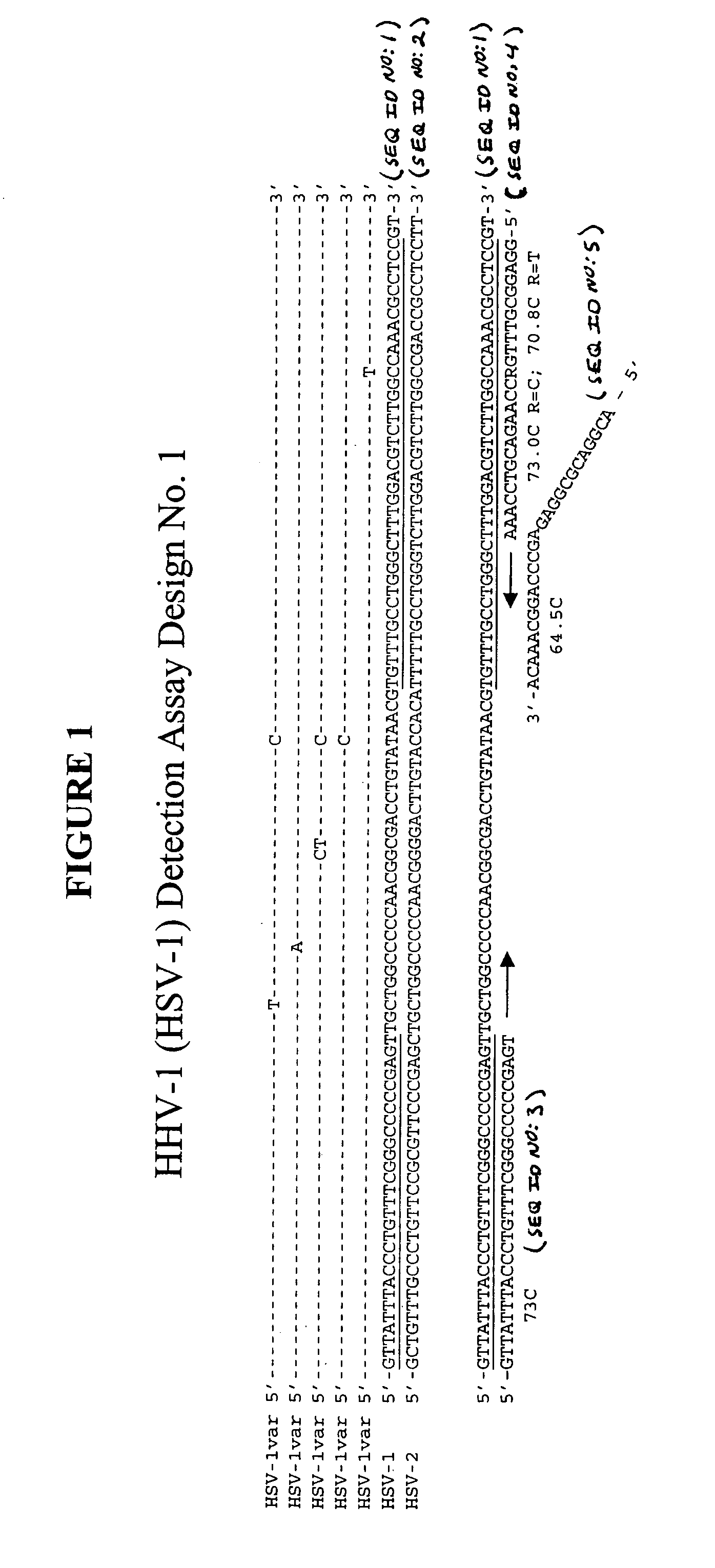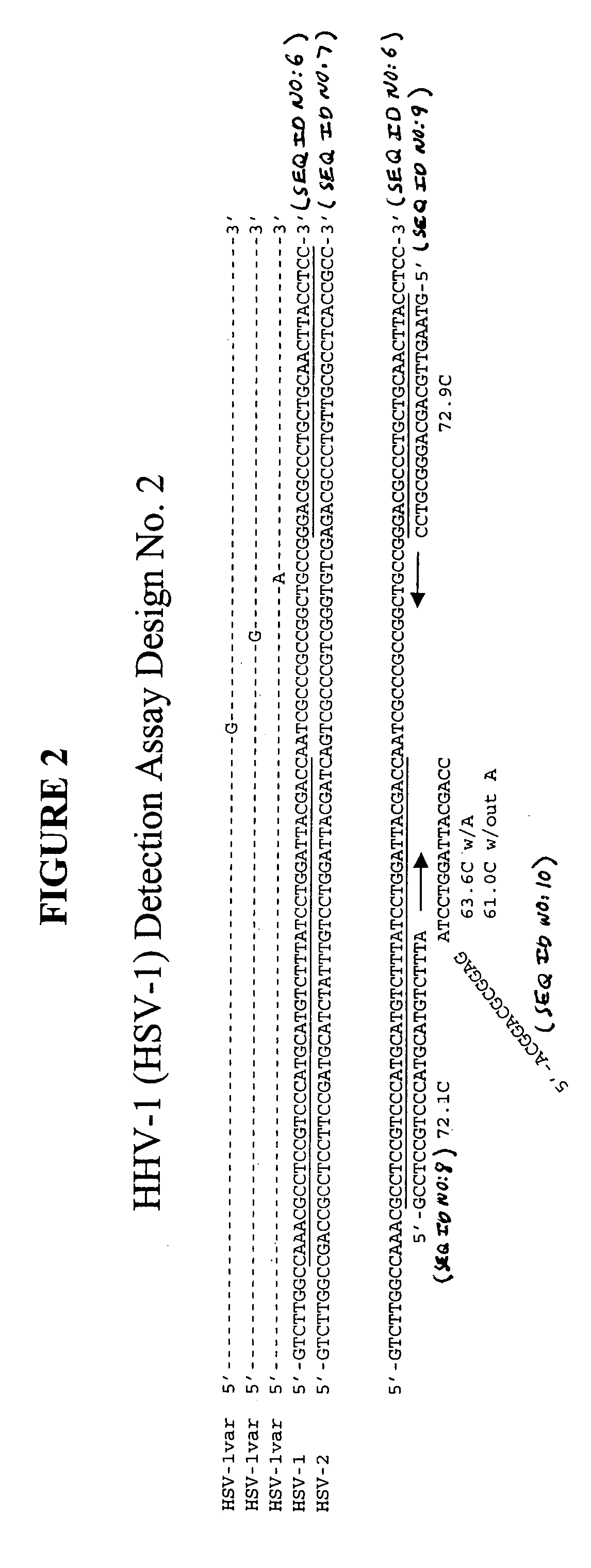Detection of human herpesviruses
a technology of human herpesvirus and detection assay, which is applied in the direction of microbiological testing/measurement, biochemistry apparatus and processes, etc., can solve the problems of high false positive and false negative detection rate of each of the diagnostic techniques described above, and limited quantitation dynamic range,
- Summary
- Abstract
- Description
- Claims
- Application Information
AI Technical Summary
Benefits of technology
Problems solved by technology
Method used
Image
Examples
example 1
Designing Herpes Virus Detection Assays
[0115] This example describes an exemplary process used to design detection assays to detect human herpes virus. In particular, this example describes the construction of PCR+INVADER detection assays for human herpes virus subtypes HHV-1 through HHV-8.
[0116] To begin designing detection assays for subtypes HHV-1-HHV-8, a particular gene from each of these subtypes was selected. Genes were selected based on the prevalence of sequence information available in the NCBI database such that conserved regions within these genes could be identified and employed in designing the assays. In this example, the following genes were selected for each of the subtypes: HHV-1—Thymidine Kinase; HHV-2—Tymidine Kinase; HHV-3—gH and gB; HHV-4—BamHI-W region (nt 33505-36576); HHV-5—DNA polymerase; HHV-6—U90 gene; HHV-7—MYG gH gene; and HHV-8—glycoprotein K1 gene.
[0117] Within each of the selected genes, the particular target sequence to be PCR amplified and then ...
example 2
Detection of HCMV (HHV-5) Nucleic Acid
[0144] The following experimental example describes the use of an invasive cleavage assay to detect HHV-5, also called human cytomegalovirus (HCMV), DNA. In this Example, HCMV DNA was detected from a prequantitated viral DNA standard using PCR amplification followed by the INVADER assay. The detection assay employed is shown in FIG. 11. The forward primer was SEQ ID NO:48 and the reverse primer was SEQ ID NO:49. The reverse PCR primer also served as the invasive oligonucleotide in the INVADER assay. The probe oligonucleotide was SEQ ID NO:51, and the FRET-labeled oligonucleotide (not shown in FIG. 11) was 5′-YTCTXAAGCCGGTTTTCCGGCTGAGACCTCGGCGCG-3′, where Y is FAM and X is Z28 (SEQ ID NO:18).
[0145] The reaction conditions were as follows: forward and reverse PCR primer at 0.4 uM each, probe oligonucleotide at 0.67 uM, FRET oligonucleotide at 0.33 uM, MOPS buffer at 10 mM, MgCl2 at 7.5 mM, dNTPs at 25 uM, native Taq polymerase at 0.3 units per r...
example 3
Detection of HCMV (HHV-5) Nucleic Acid From a Biological Specimen Sample
[0147] The following Example describes the detection of HCMV (HHV-5) nucleic acid from a biological specimen sample using an invasive cleavage assay, in this case human plasma. Nucleic acid was purified from the plasma using the Purigene kit (Gentra Systems, Plymouth, Minn.). The purified DNA was then subjected to PCR amplification and detection using the INVADER assay.
[0148] The oligonucleotides as described in Example 2 and as shown in FIG. 11 were used in this Example. The reaction conditions were as follows: forward and reverse PCR primer at 0.4 uM each, probe oligonucleotide at 0.67 uM, FRET oligonucleotide at 0.33 uM, MOPS buffer at 10 mM, MgCl2 at 7.5 mM, dNTPs at 25 uM, native Taq polymerase at 0.3 units per reaction, Cleavase VIII at 100 ng per reaction, and the balance H20 in a total reaction volume of 15 uL. 5 uL of this reaction volume was comprised of either a diluted pre-quantitated HCMV template...
PUM
 Login to View More
Login to View More Abstract
Description
Claims
Application Information
 Login to View More
Login to View More - R&D Engineer
- R&D Manager
- IP Professional
- Industry Leading Data Capabilities
- Powerful AI technology
- Patent DNA Extraction
Browse by: Latest US Patents, China's latest patents, Technical Efficacy Thesaurus, Application Domain, Technology Topic, Popular Technical Reports.
© 2024 PatSnap. All rights reserved.Legal|Privacy policy|Modern Slavery Act Transparency Statement|Sitemap|About US| Contact US: help@patsnap.com










